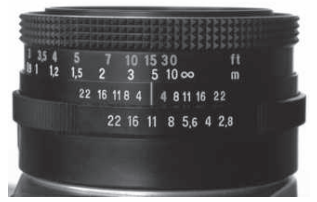The speed of a camera lens measures its ability to photograph in dim light. Speed is characterized
Question:
The speed of a camera lens measures its ability to photograph in dim light. Speed is characterized by f-ratio, also called the f-number, defined as the ratio of focal length f to lens diameter d. Thus an f/2.8 lens, for example, has diameter d = f/2.8. The actual amount of light a lens admits depends on its area A, but the inverse-square law shows that the light intensity at the camera?s imaging sensor is proportional to A/f 2 . Most cameras have an adjustable iris that obscures part of the lens to change the f-ratio in response to available light. Point and-shoot cameras adjust the f-ratio automatically, but serious photographers use their camera?s manual f-ratio adjustment (Fig. 31.37). Stopping down is the photographer?s term for reducing the lens area using the adjustable iris.
?
Increasing the f-ratio from 2.8 to 5.6a. decreases the light admitted by a factor of 2.b. decreases the light admitted by a factor of 4.c. increases the light admitted by a factor of 2.d. increases the light admitted by a factor of 4.
Step by Step Answer:






